 |
 |
 |
| |
Cardiovascular, Lipid, and Metabolic Complications of ART
|
| |
| |
CROI, Session 145 Poster Abstracts
Tuesday, February 26, 2007
Carl J. Fichtenbaum, M.D., University of Cincinnati College of Medicine
There were 14 papers presented in this session that were largely epidemiologic in nature. Dan Klein presented an update on the Kaiser database on MIs. They still do not have data on family history or smoking but it is encouraging to note that the rate of increase in MIs has slowed as the authors speculate because of improvements in recognition and care of this problem. In Abstract 808, Nina Friis-Moller and colleagues from the D.A.D. study showed that the Framingham predictive score overestimates risk in that population. It is important to note that the D.A.D study includes persons largely from Europe where there are already differences in cardiovascular risk estimation based upon presumably differences in lifestyle or other factors between Europe and the U.S. It would be useful to repeat this type of analysis in a largely U.S. cohort. I don't think we should abandon using the Framingham score just yet. In abstract 809, the same author concluded that using tipranavir+ritonavir increases cardiovascular risk compared to other PI therapies in a salvage setting. The main difference there is the higher dose of ritonavir used (200 mg twice daily) in combination with tipranavir. This is not surprising. However, as the authors note, this should not deter use of this combination since the risk of dying from HIV is much higher than the 1.75% added risk from CV mortality. In abstract 810, Mondy and colleagues from the Study of Unnatural complications (SUN) report on the baseline characteristics of Carotid IMT and Calcium scores by CT. The notable finding was the higher calcium scores and thicker IMT in persons with HIV compared to uninfected controls. The absolute risk of cardiovascular disease is low but we'll be interested to see the longitudinal data from this study in the future. In abstract 811, Bocarra and colleagues reported on a comparison of acute coronary syndromes in persons with and without HIV. No real differences found in clinical presentation and findings on angiography. In Abstract 812, Frieberg and colleagues from the VA report on the lack of association of heavy alcohol consumption on elevating cardiovascular risk in persons with HIV. This is different than HIV negative persons. The explanation behind this finding is unclear and requires further exploration. In Abstract 813, Keogh and colleagues report on fat intake in persons with HIV. Higher saturated fat intake was reported in this population and is potential target for intervention. We are definitely in the generation of processed and fast foods. Diets clearly need improvement. I think many physicians feel powerless to influence patients to alter their eating habits. However, many studies show that doctors carry respect and some clout. This is one issue that we need to keep working on with patients to improve health. After all, you are what you eat...In abstract 814, Silverberg and colleagues from Kaiser report lower than expected declines in lipid parameters in response to statin therapy in persons with HIV compared to those without HIV. This is not surprising given the data presented by Aberg and others on statin effects in persons with HIV. One of the main issues are the many drug-drug interactions that affect statin potency. In a related abstract presented at this conference Jennifer Kiser (Abstract 564) showed a blunting of anti-lipid lowering effect of rosuvastatin when combined with lopinavir/ritonavir. Thus, we do not necessarily get the same benefits from statins in persons taking antiretroviral therapy. This is an area requiring much more research. In the mean time, the take home message for clinicians is to follow lipid responses and adjust medications if necessary to improve the response. In abstract 815, Worm and colleagues from the D.A.D study presented a confusing paper on the metabolic syndrome in HIV. In this study they compared risk of MI related to the metabolic syndrome compared to teasing out specific components that comprise the diagnostic criteria for the metabolic syndrome (elevated BP, low HDL, increased waist circumference, high triglyceride levels, and elevated glucose). They found that risk was no higher when using the component parts of the metabolic syndrome versus using all factors. It is not clear how one can analyze two different measures that have nearly same factors included in both. I think we'll have to see more from this one to make sense of what's really going on here. In Abstract 816, Sabin and colleagues from the D.A.D. study report on underutilization of appropriate measures after the discovery of coronary artery disease. What cannot be gleaned from this data is whether subjects were offered therapy but declined. Furthermore, lipid levels in this study are non-fasting so it's hard to know how well interventions are doing with that factor. No data was presented on the use of beta-blockers which is common after an MI. It is not known whether these levels of interventions are similar to that of the HIV negative population merely reflecting how well our health care system does in achieving guidelines for specific diseases. In abstract 818, Jackson and colleagues present data on glucose disposal (insulin clamp) comparing saquinavir+ritonavir to atazanavir+ritonavir. Minor differences were noted favoring the atazanavir arm. I'm not sure this study would convince me to use saquinavir given that it is a relatively low potency PI with many other options available. In abstract 819, Fultz and colleagues analyzed the VA database and Medi-Cal database for intracranial hemorrhage before and after the approval of tipranavir. There was no difference in the rates. However, there was no data presented on specific use of tipranavir so that what we may be seeing is no change because of limited use. It is also possible that cases of ICH associated with tipranavir could be hidden in this dataset since there was no linkage to medications used. We'll need more information on this rare but troubling side effect. Finally, in Abstract 820, Ahonkhai and colleagues from Johns Hopkins presented data on venous thromboembolism in HIV. It appears that the risk of VTE is higher in HIV though traditional risk factors like recent hospitalization largely account for the occurrence of emboli.
807
Surveillance Data for Myocardial Infarction Hospitalizations among HIV+ and HIV- Northern Californians: 1994 - 2006
Daniel Klein*1, L Hurley2, M Silverberg2, M Horberg2, C Quesenberry2, and S Sidney2
1Kaiser Permanente, Hayward, CA, US and 2Kaiser Permanente, Oakland, CA, US
Background: Evidence mounts that protease inhibitors (PI), and perhaps other ART, increase risk of coronary heart disease (CHD) and myocardial infarction (MI), an effect not fully explained by dyslipidemia. Interventions to manage CHD risk in HIV+ patients are being undertaken with some success. However, concern remains high and estimating risk is complicated by ever-changing traditional risk factors and ART regimens. Surveillance of CHD or MI event rates in HIV+ patients compared to HIV- referent populations is needed.
Methods: We first update data from our fixed cohort of HIV+ and HIV- male members of Kaiser Permanente Northern California (KPNC) followed from 1996 to June 2006 to examine the effect of HIV and PI exposure on CHD or MI hospitalizations. Separately, we provide surveillance for CHD or MI in a dynamic cohort of all HIV+ patients, using age- and sex-matched HIV_ KPNC members (1 HIV+ to 10 HIV_) as a reference. Adjusted rates and relative rates (RR) of MI hospitalization are estimated for pre-HAART (1994-1995), early HAART (1996-1999), and late HAART (2000-June 2006). Stavudien (d4T), tenofovir (TDF), and atazanavir (ATV) use over time is reported.
Results: In the original cohort, 162 CHD events (101 MI) occurred in 30,433 person-years; rates for pre- vs post-PI exposure continue to suggest increased risk with PI exposure (CHD: 4.5 vs 7.1, p = 0.02; MI: 2.9 vs 4.4, p = 0.09). Age-adjusted RR for MI in 3 PI exposure durations compared to <2 years (ref) were 1.4 for 2 to 3.9 years, 1.8 for 4 to 5.9 years, and 1.6 for 6+ years. The overall RR for MI was 1.16 per year of PI exposure (95%CI 0.97, 1.4; p = 0.10). In the surveillance cohort (see the table), before the introduction of HAART in 1996, the RR of MI among HIV+ members vs HIV_ members (ref) was 0.85 (p = 0.65). The RR rose to 1.96 (p <0.0001) for 1996-1999 and was 1.78 (p <0.0001) for 2000-2006. Among HIV+ persons the RR of MI was 2.05 (p = 0.05) in 1996-1999 (vs 1994-1995) and 1.77 (p = 0.10) in 2000-2006. MI rates among HIV_ in these periods did not change vs 1994-1995. For 1996-2006 the RR for HIV+ women vs HIV_ women was 3.99 (p <0.001) and for HIV+ men vs HIV_ men was 1.78 (p <0.0001); d4T use declines, use of TDF and ATV go up.
Conclusions: MI rates are higher among HIV+ than among HIV_ and appear to increase with time after PI start. The effect of HIV and its treatment on MI risk was greatest early in the HAART era, but has not continued to rise, possibly due to improved risk management and shifting to more lipid friendly regimens. We find the effect of HIV on MI is greater in women. Continued risk management and surveillance are warranted.
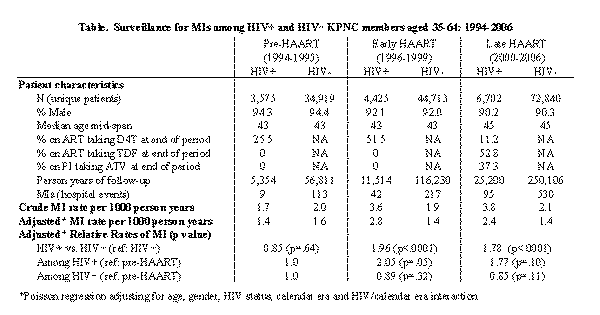
808
Predicting the Risk of Coronary Heart Disease in HIV-infected Patients: The D:A:D Risk Equation
Nina Friis-Moller*1, R ThiŽbaut2, P Reiss3, W El-Sadr4, S Worm1, O Kirk1, A Phillips5, C Sabin5, J Lundgren1, M Law6, and The D:A:D Study Group
1Copenhagen HIV Prgm, Hvidovre Univ Hosp, Denmark; 2INSERM E0338 & U593, ISPED, Univ Victor Segalen Bordeaux 2, France; 3ATHENA, HIV Monitoring Fndn, Academic Med Ctr, Amsterdam, The Netherlands; 4CPCPRA, Columbia Univ and Harlem Hosp, New York, NY, US; 5Royal Free Ctr for HIV Med, Royal Free and Univ Coll London, UK; and 6Australian HIV Observational Database, Natl Ctr in HIV Epidemiology and Clin Res, Sydney
Background: Prevention strategies for coronary heart disease (CHD) require reliable estimates of CHD risk. No such equations exist for HIV+ persons, where components of ART may contribute to this risk. We developed a CHD risk equation tailored to HIV+ patients.
Methods: Prospective multi-national cohort study of HIV+ subjects. Step 1 developed a model based on 9023 subjects who had full covariate data and were free of CHD at entry into the study. The risk equation to predict CHD was developed based on parametric survival models. Estimates from the risk equation and corresponding hazard ratios (HR) from a Cox model are reported. The performance of the equation was assessed on this development dataset by testing the prognostic system's discrimination, calibration, and accuracy. The predictive performance was also compared to that of a conventional prediction model (Framingham). Step 2 will validate the model on a separate dataset (D:A:D cohort II).
Results: Over 33,594 person-years, 157 cases of CHD occurred. The best fitting parametric model was log-logistic, and included the conventional risk factors of (b-coefficient from log-logistic model with constant = 11.498 and g = 0.933; HR from Cox model): age (per 5 years older -0.334; 1.42), sex (male -0.796; 2.35), family history of CHD (-0.478; 1.66), systolic blood pressure (per 10 mmHg higher -0.050; 1.05) and smoking status (current -1.042, ex -0.456; 2.97, 1.78), the ratio of TC/HDL (per unit higher -0.144; 1.16), diabetes (fitted separately by sex due to interaction (in men -0.683, women -1.349; 1.94 and 4.04)), and in addition duration of protease inhibitor (PI) exposure (per additional year -0.114; 1.13). Age, PI exposure, and smoking status were fitted as time-updated, while all other covariates took the fixed value at baseline for the analyses. The area under the receiver-operator characteristic curve discrimination statistic was 0.78 (95%CI 0.75 to 0.82). Overall, the D:A:D equation predicted 153 CHD events, compared with 187 events predicted by the Framingham equation. Predictions were accurate in sub-groups of patients according to sex and smoking status (see the table).
Conclusions: The Framingham risk equation over-predicted CHD events in this cohort. In contrast, the D:A:D equation, developed on HIV+ subjects and incorporating PI exposure as well as conventional CHD risk parameters, accurately predicted CHD outcomes in the development dataset.
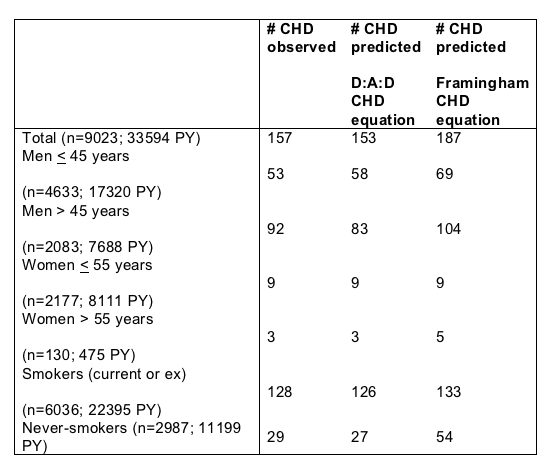
809
Predicted Risk of Coronary Heart Disease with Tipranavir Exposure Compared to Conventional PI in the RESIST Trial
Nina Friis-Moller*1, M Kraft2, H Valdez3, D Hall3, and J Lundgren1
1Copenhagen HIV Prgm, Hvidovre Univ Hosp, Denmark; 2Boehringer Ingelheim GmbH, Ingelheim am Rhein, Germany; and 3Boehringer Ingelheim Pharma, Ridgefield, CT, US
Background: The use of ritanovir-boosted tipranavir (TPV/r) is indicated in treatment-experienced patients. Elevation of lipid levels have been observed more frequently after use of TPV/r (500 mg/200 mg twice daily) than after use of other low-dose ritonavir-boosted protease inhibitors (PI). It is of interest to estimate the potential added risk for coronary heart disease (CHD) associated with TPV/r use compared with conventional ritonavir-boosted PI (CPI/r).
Methods: In treatment-experienced patients, mean 5-year CHD risk was modelled according to metabolic factors observed at baseline and week 8 of the RESIST trials. The CHD risk estimates were calculated using the Framingham risk equation, a parametric statistical model controlling for multiple cardiovascular risk factors (including age, sex, diabetes, prior cardiovascular disease, the ratio of serum total cholesterol to HDL cholesterol [TC:HDL]); and imputed average values of blood pressure (120 mmHg) and smoking (45%). Different average values were considered in sensitivity analyses. The numbers needed to treat to harm one person (NNTH) were calculated from the absolute CHD risk difference between the study arms.
Results: In the RESIST trials, 746 (median age 43 years, IQR 38 to 49; 15.7% women) and 737 (42 years, 38 to 48;11.7% women) individuals were randomized to TPV/r and CPI/r, respectively. Week-8 data were available for 630 and 613 individuals. Over the first 8 weeks of exposure, the TC:HDL ratio increased from 5.1(4.1 to 6.3) to 6.0 (4.7 to 7.6) in the TPV/r arm, while from 5.0 (4.1 to 6.2) to 5.2 (4.1 to 6.5) in the CPI/r arm (difference between arms, p <0.0001). At baseline, the predicted CHD risk was quite similar for both arms. However, at 8 weeks of exposure the modelled CHD risk differed (see the figure). The mean predicted average risk of CHD over a 5-year period is 1.75% overall in the TPV/r arm versus 1.32% in the CPI/r arm, for an attributable NNTH estimate of 234 (1/[0.0175 to 0.0132]).
Conclusions: In summary, these findings suggest that in highly treatment-experienced patients requiring a boosted PI regimen, the potential added harm on risk of CVD induced by TPV/r (500 mg/200 mg twice daily) versus CPI/r is present, but limited in absolute terms in most patients. The differences in predicted absolute risks between the TPV/r and CPI/r arms results in estimated NNTH in the range of 150 to 300 for the men in the study over a 5-year period; the NNTH is considerably higher for women.
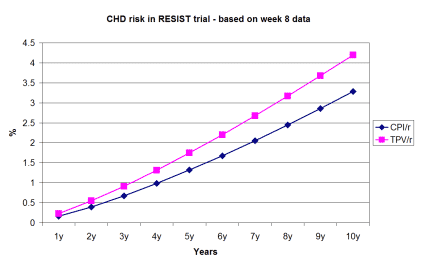
810
Carotid Intima-media Thickness, Coronary Artery Calcium Scores, and Framingham Risk Scores among HIV-infected Patients in the Study to Understand the Natural History of HIV/AIDS in the Era of Effective Therapy
Kristin Mondy*1, K Henry2, E Overton1, T Bush3, L Conley3, K Lichtenstein4, E Kojic5, W Mack6, H Hodis6, J Brooks3, and SUN Study Investigators
1Washington Univ Sch of Med, St Louis, MO, US; 2HIV Prgm, Hennepin County Med Ctr, Univ of Minnesota, Minneapolis, US; 3CDC, Atlanta, GA, US; 4Univ of Colorado Hlth Sci Ctr, Denver, US; 5The Miriam Hosp, Providence, RI, US; and 6Univ of Southern California, Los Angeles, US
Background: Increased risk of coronary artery disease (CAD) is a concern for HIV-infected persons because of standard risk factors in addition to HAART- and HIV-related contributions to atherosclerosis.
Methods: The Study to Understand the Natural History of HIV/AIDS (SUN) is a prospective cohort of 687 HIV-infected patients receiving care at clinics in Denver, Minneapolis, Providence, and St. Louis. At baseline, carotid intima-media thickness (cIMT), carotid artery calcium scores (CACS) by CT scan, and clinical and fasting laboratory data were obtained on all subjects. We used multivariate logistic regression to identify independent predictors of increased cIMT from among factors significant in univariate analyses. Odds ratios were determined using cIMT >median value. cIMT, CACS, and Framingham risk scores (FRS) were correlated. cIMT of subjects was compared with that of a healthy HIV-uninfected cohort from the University of Southern California who had similar distribution of cardiovascular disease (CVD) risk factors, matched by age, gender, and diabetes.
Results: Characteristics of 258 subjects with available data who could be matched to HIV-negative persons were as follows: median age 44 years, 23% women, 22% African American, median body mass index 25.1 kg/m2, median CD4 cell count 447 cell/µL, 46% active smokers, 11% active cocaine users, 22% hypertensive, 9% diabetic, and 84% on HAART. In multivariate analyses, higher cIMT in SUN subjects was associated with male gender (odds ratio [OR] 3.4, 95%confidence interval [CI] 1.7 to 7.4), African American race (OR 3.0, CI 1.5 to 6.4), age >44 years (OR 2.2, CI 1.3 to 3.7), hypertension (OR 2.2, CI 1.3 to 3.9), and having ever smoked tobacco (OR 2.2, CI 1.2 to 3.9), but not type/duration of HAART. Compared to HIV-uninfected persons, SUN subjects had higher median cIMT (0.74 vs 0.69 mm, p <0.001). This difference persisted in the subset of 139 pairs with matched current smoking status (0.73 vs 0.70 mm, p = 0.005). Groups did not differ by race or prevalence of hypertension, elevated fasting glucose, or menopause. Despite higher triglycerides, SUN subjects had lower HDL and LDL cholesterol, lower body mass index, and lower FRS (all p <0.001) than those of HIV-negatives. In 246 SUN subjects with baseline cIMT, CACS, and FRS, the FRS correlated moderately well with both cIMT (r = 0.38) and CACS (r = 0.32; both <0.001 by Spearman's rank test).
Conclusions: HIV-infected persons had higher cIMT compared with matched HIV-uninfected controls, but overall CVD risk was low in this cohort. Traditional CAD risk factors outweighed the contribution of HAART to increased cIMT and as captured by FRS, correlated moderately with cIMT and CACS.
811
Clinical and Angiographic Features of Acute Coronary Syndromes in HIV-infected Compared with Non-HIV-infected Patients
F Boccara1, M Mary-Krause2, E Teiger1, S Lang1, P Lim1, K Wahbi1, J Collet1, F Beygui1, Dominique Costagliola*2, A Cohen1, and Sponsored by the French National Agency for Research on AIDS and Viral Hepatitis
1Univ Paris V, VI, XII, Paris, France and 2INSERM UMR S720, Paris, France
Background: Acute coronary syndrome (ACS) is an emerging complication in HIV-infected patients under HAART, but specific characteristics of ACS in HIV-infected patients remain unknown.
Methods: Between September 2003 and March 2006, we enrolled prospectively 104 HIV+ patients and 184 controls (HIV-) admitted for ACS matched for age (±5 years), gender, and type of ACS in 20 different intensive care cardiolgy units.
Results: The mean age of patients was 48.7±9.1 years, and 92.7% were men. Baseline clinical and angiographic characteristics are shown in the table. The most frequent type of ACS was ST segment elevation myocardial infarction (52.1%), then unstable angina (26.1%) and non-ST segment elevation myocardial infarction (21.5%). At admission, Killip class 2 or more was more frequent in HIV+ than HIV- participants (8.9% vs 3.4%, p = 0.049). However, left ventricular ejection fraction was similar in both groups (54.2% vs 54.5%, p = 0.79). Percutaneous coronary intervention was performed less frequently in HIV+ than HIV- (72.6% vs 86.3%, p = 0.005) as the use of GPIIbIIIa (31.7% vs 45.1%, p = 0.026), but with the same procedural immediate success rate achieved (97%) and rate of stenting (96%). The rate of bare metal and drug-eluting stents implanted was similar in both groups (63% vs 64%, p = 0.5 and 37% vs 36%, p = 0.9, respectively).
Conclusions: HIV-infected patients did not differ from non-HIV-infected patients regarding baseline clinical and angiogaphic characteristics during a first episode of ACS. Follow-up of this observational prospective study will continue during 3 years.
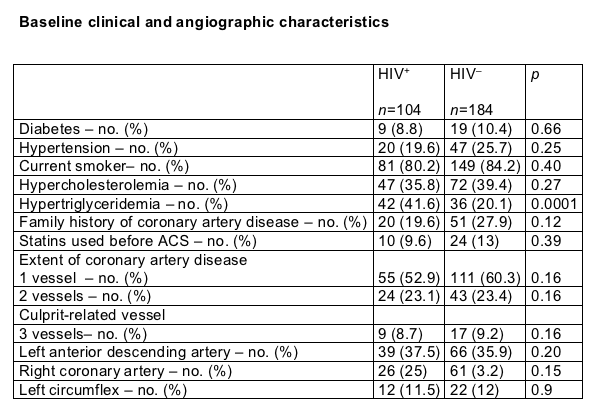
812
Current Alcohol Consumption and Cardiovascular Disease among Men Infected with HIV
Matthew Freiberg*1, K Kraemer1, J Samet2, J Conigliaro3, R Ellison2, K Bryant4, L Kuller1, A Justice5, and Veterans Aging Cohort Study Project Team
1Univ of Pittsburgh, PA, US; 2Boston Univ, MA, US; 3Univ of Kentucky, Lexington, US; 4Natl Inst on Alcohol Abuse and Alcoholism, NIH, Rockville, MD, US; and 5West Haven VAMC and Yale Univ, New Haven, CT, US
Background: In the general population, the association between alcohol consumption and cardiovascular disease (CVD) is J-shaped with moderate drinkers at the lowest risk, infrequent drinkers at intermediate risk, and hazardous drinkers at the highest risk. The reduced risk associated with moderate alcohol consumption is mediated in part by improved lipid profiles and increased insulin sensitivity. ART is associated with dyslipidemia and increased insulin resistance. Whether the association between alcohol consumption and CVD is J-shaped among HIV+ people is unknown.
Methods: We performed cross-sectional analyses using survey and laboratory data from 2028 HIV+ and 1927 HIV- male subjects from the Veterans Aging Cohort Study, a prospective observational cohort of U.S. veterans with and without HIV. We used logistic regression to calculate the odds ratio (OR) for the prevalence of CVD (defined as a self-reported history of angina, coronary heart disease/myocardial infarction, congestive heart failure, or stroke/transient ischemic attack) among those who currently drink alcohol infrequently (<1 drink/week), moderately (1 to 14 drinks/week and <6 drinks/occasion), or hazardously (>14 drinks/week or >6 drinks/occasion).
Results: The prevalence of infrequent, moderate, and hazardous drinking was 23.9%, 25.1%, and 51.1%, respectively, for HIV+ subjects and 23.6%, 22.9%, and 53.4%, respectively, for HIV- subjects. The prevalence of CVD among infrequent, moderate, and hazardous drinkers was 11.6%, 10.0%, and 13.6%, respectively, for HIV+ subjects and 18.3%, 17.0%, and 17.0%, respectively, for HIV- subjects. After adjusting for age, race, height, weight, lipids, diabetes, hypertension, smoking, CD4 count, ART, liver and kidney disease, hepatitis C, and exercise, the OR for CVD among HIV+ subjects was 1.09 (0.69 to 1.72) for moderate and 1.63 (1.10 to 2.41) for hazardous drinkers as compared with infrequent drinkers. Among HIV- subjects, the adjusted OR (excluding CD4 count and ART) for CVD was 0.74 (0.51 to 1.09) for moderate and 0.92 (0.67 to 1.27) for hazardous drinkers as compared with infrequent drinkers.
Conclusions: For HIV+ veterans the J-shaped relationship between alcohol and CVD was not observed after adjusting for confounders. Among HIV- veterans, a J- shaped relationship was observed although not statistically significant. Assumptions about alcohol's impact on CVD risk among HIV+ men based on general population findings should be avoided.
813
Increased Fat and Cholesterol Intake and Relationship to Serum Lipid Levels among HIV-infected Patients in the Current Era of HAART
H Keogh1, T Joy1, C Hadigan1,2, C Hadigan1,2, K Fitch1, S You1, J Liebau1, J Lo1, S Johnsen1, S Dolan1, and Steven Grinspoon*1
1Massachusetts Gen Hosp, Boston, US and 2NIH, Bethesda, MD, US
Background: Limited information is available on fat and cholesterol intake in HIV-infected patients. Furthermore, the influence of diet on lipid parameters is unknown in this population. Dietary modification of fat intake may be an important metabolic strategy in HIV-infected patients at risk for cardiovascular disease.
Methods: We evaluated the relationship between macronutrient intake and metabolic parameters in 373 non-wasting, HIV-infected subjects (207 males, 166 females), as well as 164 healthy community controls (82 males, 82 females). HIV+ and HIV- subjects who volunteered for metabolic studies between 1998 and 2005 at Massachusetts General Hospital, Boston, were included. Dietary intake was determined from 4-day food records and diet history. Data were analyzed using fit modeling, controlling for age, race, gender, and for study number as random effect.
Results: Age (42±7 vs 42±10 years, p = 0.90), race (57.2 vs 62.8% Caucasian, p = 1.0), and gender (55.5 vs 50.0% male, p = 0.99) were not different between HIV and control subjects, respectively; 69% of HIV subjects were receiving protease inhibitors (PI) and 35% of HIV subjects met the criteria for metabolic syndrome compared to 24% of controls (p = 0.0004). Dietary saturated fat and cholesterol intake were significantly increased among HIV+ subjects compared to controls (p = 0.04 and p = 0.03, respectively). A significantly greater percentage of HIV-infected subjects were above the U.S. recommended dietary allowances (RDA) for total fat (>30%/day) (77.0% HIV+ vs 69.9% controls, p = 0.04), saturated fat (>10%/day) (76.7% HIV+ vs 64.1% controls, p = 0.003), and cholesterol (>300 mg/day) (50.3% HIV+ vs 40.0% controls, p = 0.02).
HIV+ subjects demonstrated higher triglyceride levels (p = 0.0006), lower HDL levels (p <0.0001), higher visceral : subcutaneous abdominal fat ratio (p = 0.0008), higher insulin levels (p = 0.03), and increased waist-to-hip ratios (p <0.0001) compared to controls. Both saturated fat intake (p = 0.02) and cholesterol intake (p = 0.02) were significantly associated with plasma triglyceride levels among the HIV-infected subjects in multivariate regression modeling controlling for PI use, alcohol, total fat intake, and insulin levels.
Conclusions: Increased intake of saturated fat and cholesterol occurs in HIV+ patients with metabolic abnormalities in the current era of HAART. This increase in saturated fat and cholesterol intake contributes to hypertriglyceridemia in this population and should be targeted for dietary modification.
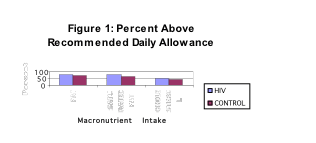
814
Lipid-lowering Therapy Responses in HIV+ and HIV- Dyslipidemic Patients Enrolled in a Large Integrated Healthcare Delivery System
Michael Silverberg*, W Leyden, M Horberg, L Hurley, A Go, C Quesenberry, and D Klein
Kaiser Permanente, Oakland, CA, US
Background: Differences in responses to lipid lowering therapy (LLT) by HIV status and HAART class are largely unknown.
Methods: In Kaiser Permanente Northern California, we identified HIV+ and HIV- patients treated with LLT from 1996 to 2005 in 3 cohorts defined by dyslipidemia type: total cholesterol (TC) ≥240 mg/dL; LDL ≥160 mg/dL or ≥130 if ≥2 coronary heart disease (CHD) risk factors or ≥100 if CHD; and triglycerides (TG) ≥500 mg/dL. HIV+ patients aged ≥18 years and age-, sex-, and year-matched HIV- patients were included. Exclusions were prior dyslipidemia dialysis and prior LLT. Cohorts were not mutually exclusive. In each cohort, we estimated adjusted percentage of changes in lipids by HIV status 1 year after LLT start using linear regression controlling for sex, age, baseline lipid levels, year, prior CHD/diabetes/hepatitis dialysis, CHD risk factors, and LLT class and duration. Among HIV+ patients, we estimated adjusted percentage changes in lipids by HAART class with additional adjustments for baseline CD4, HIV RNA, and AIDS. Adjusted odds ratios (OR) for achieving Adult Treatment Panel III (ATP III) lipid goals were estimated using logistic regression controlling for the same factors.
Results: Cohorts included 6862 patients (907 HIV+) with high TC, 6496 patients (695 HIV+) with high LDL, and 5182 patients (511 HIV+) with high TG. The most common LLT were statins: 87%, 89%, and 52% in the 3 cohorts, respectively. Of note, dosing of individual LLT was similar by HIV status, but drugs used differed (eg, HIV+ patients had more pravastatin use, p <0.001 for all 3 cohorts). HIV+ patients had significantly smaller declines in TC, LDL, and TG compared to HIV- patients (see the table), although differences in percentage change between HIV+ and HIV- patients were larger for TC (4.4%) and TG (17.4%) than for LDL (1.8%). HIV+ patients on PI+NNRTI had the smallest declines in TC and TG compared to other HIV+ patients, but no differences by HAART class were found for LDL (see the table). Compared to HIV- patients, HIV+ patients had lower odds of attaining ATP-III lipid goals for TC (OR 0.57, p <0.001), LDL (OR 0.81, p = 0.017), and TG (OR 0.39, p <0.001).
Conclusions: Declines in LDL in response to LLT are similar in HIV+ and HIV- patients, but declines in TC and TG levels are less prominent in HIV+ patients. Differences in choice of LLT among HIV+ due to concerns of drug-drug interactions and toxicity may in part explain results for TC. PI+NNRTI regimens also associated with inferior TC and TG responses.
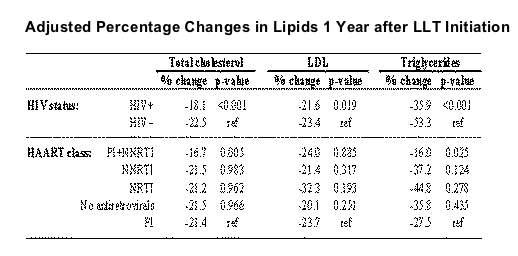
815
Presence of the Metabolic Syndrome Is Not a Better Predictor of Cardiovascular Disease than the Sum of its Components: Data from the D:A:D Study
Signe W Worm*1, C Sabin2, P Reiss3, W El-Sadr4, A D'Arminio Monforte5, M Law6, M Rickenback7, S De Wit8, J Lundgren1, N Friis-Moller1, and The D:A:D Study Group
1Copenhagen HIV Prgm, Hvidovre, Denmark; 2Royal Free Ctr for HIV Med, Royal Free and Univ Coll London, UK; 3ATHENA, HIV Monitoring Fndn, Academic Med Ctr, Amsterdam, The Netherlands; 4CPCPRA, Columbia Univ and Harlem Hosp, New York, NY, US; 5ICONA, Hosp San Paolo, Univ of Milan, Italy; 6Australian HIV Observational Database, Natl Ctr in HIV Epidemiology and Clin Res, Sydney; 7Swiss HIV Corhort Study, Univ Hosp Lausanne; and 8Ctr Hosp Univ St Pierre, Brussels, Belgium
Background: The metabolic syndrome is a cluster of cardiovascular disease (CVD) risk factors thought to be associated with a 2-fold increased risk of CVD in the general population. It is much debated whether the metabolic syndrome (defined as ≥3 risk factors) contributes additional information over and above that provided by the individual risk factors alone. In a population of HIV infected persons, we investigated whether combinations of risk factors lead to a higher than expected CVD risk.
Methods: Prospective multi-national cohort study of 23,236 HIV-infected subjects. The effect of combinations of components of the metabolic syndrome for the risk of a composite CVD endpoint (myocardial infarction, stroke, and invasive procedures) was assessed by Poisson regression by incorporating interactions between each pair of risk factors (adjusting for age, sex, family history of CVD, smoking status, calendar year, and exposure to cART). We considered triglycerides ≥1.7mmol/L, HDL cholesterol ˛1.0 mmol/L in men, ˛1.3 mmol/L in women (HDL), systolic blood pressure >130 or diastolic blood pressure >85 mmHg, body mass index >25 kg/m2, and a diagnosis of diabetes mellitus. The results were validated in a dataset of n = 10,143 individuals.
Results: An increased CVD risk was found with increasing number of concomitant risk factors (unadjusted relative rate per additional factor: 1.70, 95%CI 1.50 to 1.93). When exploring pairwise combinations, the highest CVD rates (per 100 persons years) were seen in patients with high blood pressure and body mass index (3.27 vs 0.46 in patients with no high blood pressure and normal body mass index, diabetes mellitus, and decreased HDL (3.26 vs 0.54 in patients with no diabetes mellitus and normal HDL), high blood pressure and elevated triglycerides (3.01 vs 0.34 in patients without high blood pressure and with normal triglycerides) and diabetes mellitus and elevated triglycerides (2.47 vs 0.37 in patients with normal triglycerides and no diabetes mellitus. There were no positive interactions between the pairwise combinations of risk factors. After adjusting for each of the individual risk factors as well as other confounders, there was no independent association with having metabolic syndrome (1.03, 95%CI 0.63 to 1.68).
Conclusions: There is a strong correlation between the number of the components of the metabolic syndrome observed together in individual patients and CVD risk. However, when seen together, the combined effect of these factors for the risk of CVD is comparable to that expected by multiplying their individual effects. Thus, presence of metabolic syndrome in HIV appears not to increase the CVD risk over and above that conferred by the components of the syndrome separately.
816
Underutilization of Recommended Interventions for Prevention of Cardiovascular Disease in HIV-infected Patients with Established Cardiovascular Disease or Diabetes
Caroline Sabin*1, R Weber2, E Fontas3, F Dabis4, P Reiss5, S De Wit6, O Kirk7, S Worm8, N Friis-Moller8, J Lundgren8, and The D:A:D Study Group
1Royal Free Ctr for HIV Med, Royal Free and Univ Coll London, UK; 2Swiss HIV Corhort Study, Univ Hosp Zuric; 3Nice Cohort, Ctr Hosp Univ Nice, Hosp de l'Archet, France; 4INSERM E0338 & U593, ISPED, Univ Victor Segalen Bordeaux 2, France; 5ATHENA, HIV Monitoring Fndn, Academic Med Ctr, Amsterdam, The Netherlands; 6Ctr Hosp Univ St Pierre, Brussels, Belgium; 7EuroSIDA, Copenhagen HIV Prgm, Hvidovre Univ Hosp, Denmark; and 8Copenhagen HIV Prgm, Hvidovre, Denmark
Background: In HIV- populations with established cardiovascular disease (CVD) or diabetes, various interventions are recommended for the prevention of CVD events and CVD-related mortality. Few data are available on the use of these interventions, particularly lipid-lowering drugs (LLD) and smoking cessation, in HIV-infected individuals.
Methods: We identified all individuals who had a first CVD event (myocardial infarction, stroke, invasive CVD procedure) or were diagnosed with diabetes mellitus during follow-up in the D:A:D Study (December 1999 to February 2006). Use of LLD prior to the CVD event/diagnosis and over the next 6 months, as well as CVD risk factors (including use of protease inhibitors [PI]) was assessed among patients with >6 months follow-up. Statistical analysis was by _2 test.
Results: Of the total, 348 patients had a first CVD event (204 myocardial infarction, 73 stroke, 71 invasive procedure); 9% male, median age 49 years, 14% family history of CVD. At the time, 149 (43%) were smokers (244 (70%) had ever smoked), 80 (23%) were receiving LLD and 184 (53%) PI. Overall, 149 (56%) of those not on LLD started these drugs in the next 6 months; LLD initiation increased from 17% in 1999/2000 to 71% in 2005/2006 (p = 0.007), and was more common after a myocardial infarction (52%) or invasive procedure (46%) than after stroke (28%, p = 0.007). Rates were similar after restricting the analysis to those with a total cholesterol of >3.5 mmol/L. Only 24 of 149 (16%) stopped smoking (myocardial infarction 21%, stroke 4%, invasive procedure 0%) and 38 of 184 (21%) stopped their PI. Among 626 patients diagnosed with diabetes (82% male, median age 46 years, 10% family history of CVD), only 32 of 512 (6%) not on LLD started these drugs in the next 6 months, 10 of 193 (5%) smokers ceased smoking, and 86 of 316 (27%) on protease inhibitors stopped this drug class. There was no difference in the initiation of LLD over time in patients diagnosed with diabetes (p = 0.27).
Conclusions: Initiation of LLD following a CVD event has increased over time, although was only 70% in the most recent time period and was less common in those with stroke than myocardial infarctions or invasive procedures. Only a fifth of diabetics, a group at high risk for CVD mortality, not on LLD initiated such primary prevention. Smoking cessation was rare in both groups. Greater emphasis should be placed on increasing use of LLD and reducing modifiable risk factors such as smoking.
818
Effects of Atazanavir or Saquinavir Once Daily with Ritonavir 100 mg and Tenofovir/Emtricitabine as Initial Therapy for HIV-1 Infection on Peripheral Glucose Disposal: A Randomized Open-label Study
Akil Jackson*, N Patel, G Lo, B Gazzard, and G Moyle
Chelsea and Westminster Hosp, London, UK
Background: Some HIV-1 protease inhibitors (PI) are associated with insulin resistance. Healthy volunteer studies of unboosted 400 mg atazanavir (ATV) for 5 days did not alter glucose disposal rates during hyperinsulinaemic euglycaemic clamp. Changes observed in similar studies have included a 10% reduction in glucose disposal with atazanavir/ritonavir (ATV/r) 300/100 mg, a 17% reduction in glucose disposal on indinavir (IDV) for 4 weeks, and a 23% lower insulin sensitivity index with lopinavir/ritonavir (LPV/r) over 5 days of therapy. There are no data on the effect of either atazanavir or saquinavir (SQV) on glucose disposal when given as part of initial regimens to HIV-1-infected patients.
Methods: A single-center, prospective randomized, open-label trial comparing the SQV/r 2000/100 mg with ARV/r 300/100 mg, with tenofovir (TDF)/emtricitabine (FTC) on glucose disposal rates during hyperinsulinemic euglycemic clamp performed at baseline and after morning dosing at week 4.
Results: We randomized 22 HIV-1-infected males, na•ve to ART and without metabolic disorders. Whole-body insulin sensitivity was determined by 180 minute hyperinsulinemic euglycemic clamp (40 mUnit.m-2.min-1). We assigned 10 patients to the SQV arm and 12 to ATV with mean age (SD) of 38 (±5.1) vs 38 (±4.6) years. Baseline median CD4 count was 224 vs 232 cells.mm-3, with a median viral of 5.00 vs 4.92 log10 copies.mL-1 for SQV and ATV arms, respectively. Mean (SD) total body mass were 70.8 kg.m-2 (11.7 and 23.1) for SQV compared with 75.5 kg.m-2 (8.2 and 25.5) for ATV. The median percentage change in glucose disposal rate for treatment with SQV was a 10.8% decrease (range -33.6 to +32.0%) compared with a median increase of 2.3% (range -26.4 to +103.7%) in those patients on ATV. Median changes in lipid parameters over 4 weeks for SQV and ATV were: total cholesterol (+7.4 vs +6.1%), fasting triglycerides (+39.4 vs +11.5%), HDL cholesterol (+0.7 vs +7.9%), and LDL-cholesterol (+0.7 vs +4.0%), respectively.
Conclusions: Variable changes in glucose disposal are seen with both SQV/r and ATV/r at 4 weeks after initiation of antiretroviral therapy, with a modest median reduction in glucose disposal with SQV/r. Changes observed in the HIV treatment setting may differ from those observed in healthy volunteers. Lipid changes were modest with more favorable changes in triglycerides and HDL observed with ATV/r.
819
Evaluation of Intracranial Hemorrhage in 49,610 HIV-infected Veterans and California Medicaid Recipients
Shawn L Fultz*1,2, Shawn L Fultz*1,2, D Zingmond3, K Gordon2, J Goulet2, L Mole4, J King, Jr1,2, J King, Jr1,2, D Bravata1,2, D Bravata1,2, H Valdez5, M Kraft6, A Justice1,2, A Justice1,2, and VACS Project Team
1VA Connecticut Hlthcare System, West Haven, US; 2Yale Univ Sch of Med, New Haven, CT, US; 3Univ of California, Los Angeles, US; 4VA Palo Alto Hlthcare System, CA, US; 5Boehringer Ingelheim Pharma, Ridgefield, CT, US; and 6Boehringer Ingelheim Pharma, Inc, Ingelheim, Germany
Background: In pre-approval trials, 13 of 6840 patients (0.20%) exposed to tipranavir (TPV) have developed intracranial hemorrhage (ICH) at an incident rate of 0.26/100 person-years of exposure (95%CI 0.09, 0.82). It is unknown whether this rate exceeds that observed with other HAART. We sought to examine the rate of ICH in an HIV-infected population not exposed to TPV in the HAART era.
Methods: We identified HIV-infected individuals under care in the U.S. Veterans Healthcare System (VA) and California state Medicaid (Medi-Cal) program between October 1997 and December 2003. We used data from the VA national electronic medical record and Medi-Cal claims combined with California hospital discharge abstracts to identify intracranial hemorrhage among subjects presenting for HIV care between October 1997 and December 2003 (ICD-9-CM diagnostic codes 430.xx, 431.xx, 432.xx except 432.0). Prevalence was defined as ICH events occurring from 12 months before to 6 months after date of initial presentation for HIV care. Incidence (per 100 person-years) was defined as events occurring after this time frame.
Results: Overall 16,573 veterans and 33,037 Medi-Cal recipients presented for HIV care during this observation period. Results are given in the table.
Conclusions: This analysis presents a range for the incidence of ICH in the setting of HIV infection that appear similar to rates reported in TPV pre-approval trials. The higher rate seen in Medi-Cal may reflect the higher rate of clinical AIDS. In addition, ICH events may be less commonly captured in the VA system because patients with acute ICH may present to non-VA hospitals for their initial care. In both samples, ICH is more common among older individuals and those who have developed AIDS (88% of patients who had an ICH in TPV studies had AIDS; 63% were >40 years).
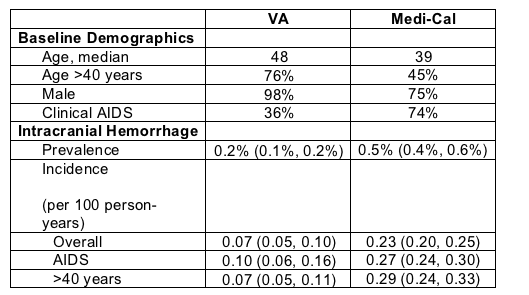
820
Venous Thromboembolism in Patients with HIV: A Case-control Study
Aima Ahonkhai*, K Gebo, M Streiff, R Moore, and J Segal
Johns Hopkins Univ Sch of Med, Baltimore, MD, US
Background: Retrospective cohort studies of HIV-infected patients suggest an incidence of venous thromboembolism (VTE) of 1 to 2%, 10 times that expected in a comparable HIV- adult population. The reasons for this elevated risk are unclear. We aimed to investigate the prevalence of established risk factors for VTE in this population and explore novel risk factors for VTE.
Methods: We assessed the incidence of newly diagnosed VTE, based on radiological tests and clinical course consistent with VTE, in patients of the Johns Hopkins HIV Clinical Cohort. Using non-VTE controls matched on enrollment date and follow-up time, a nested case-control study determined risk factors for VTE.
Results: We identified 160 cases of VTE, 23% of which occurred among inpatients. The incidence of VTE was 5.1 per 100 person-years of follow-up. Cases and controls did not differ by sex, but black patients were overrepresented among cases (odds ratio of 1.85, p = 0.02), and cases were older than controls (mean 39 years vs 37 years, p <0.001). Cases had more advanced HIV disease than did controls, as evidenced by lower CD4 counts (227 vs 362 cells/mm3, p <0.0001), higher HIV RNA titers (116,325 vs 71,262 p = 0.02), and lower hemoglobin levels (10.9 g/dL vs 12.7 g/dL, p <0.0001) preceding the event. Other factors associated with VTE cases include higher white blood cell counts (6567/mm3 vs 4184 /mm3, p <0.0001), and hospitalization within the prior 3 months (67 vs 12%, p <0.0001). HAART, whether non-nucleoside reverse transcriptase inhibitors (NNRTI) or protease inhibitor (PI) -based regimens, was not associated with VTE. In multivariate analyses, higher risk of VTE was associated with any hospitalization in the past 3 months (OR = 12, p <0.0001), diagnosis of lymphoma (OR = 6.7, p = 0.05), central venous catheter use (OR = 4.8, p <0.0001), and a white blood cell count above the median (OR = 2.0, p = 0.009). A CD4 count >500 cells/mm3, independent of these other risks, was protective (OR = 0.30, p = 0.014)
Conclusions: We found an even higher incidence of VTE among patients with HIV than has been previously reported. Though most events occurred among outpatients, the strongest predictor of VTE was recent hospitalization. Inflammation, as suggested by white blood cell count elevation, was also independently associated with VTE. A high CD4 count was protective.
|
| |
|
 |
 |
|
|